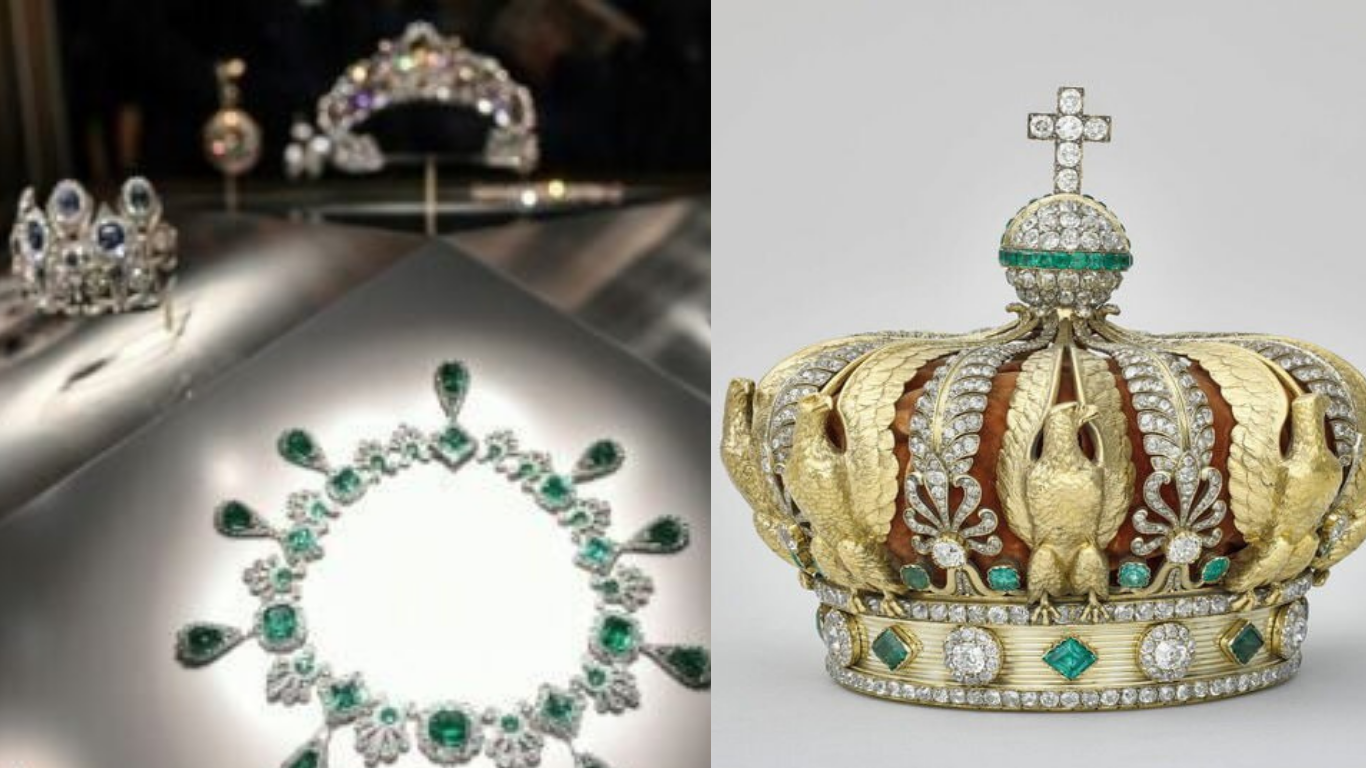
Paris, October 22, 2025 – Just three days after a shocking robbery that has left the art world reeling, the Louvre Museum is back open to visitors, but the hunt for the culprits continues. On the morning of October 19, four thieves pulled off a daring daylight theft, making off with eight priceless pieces from France’s Crown Jewels collection. Valued at around €88 million – that’s roughly $102 million or about 850 crore Indian rupees – the heist has sparked questions about museum security and drawn comparisons to famous art crimes of the past. French police are on high alert, with Interpol now involved, as details emerge about how the crime unfolded in just seven minutes.
The incident happened right in the heart of one of the world’s most visited museums, home to treasures like the Mona Lisa and the Venus de Milo. But this time, the target was the Galerie d’Apollon, a grand hall filled with royal artifacts from France’s imperial history. Eyewitnesses described a scene straight out of a movie: men in hard hats and work vests blending in with ongoing renovation crews, suddenly smashing display cases and grabbing jewels before vanishing into the streets of Paris.
How the Robbery Unfolded: A Step-by-Step Breakdown
It all started at about 9:30 a.m. on a quiet Sunday morning. The Louvre had just opened its doors, and the early crowd was thin. Security footage, now released by authorities, shows the four suspects entering through a side entrance used by staff and contractors. Dressed as construction workers, complete with tool belts and helmets, they didn’t raise any alarms at first. The museum was in the middle of some upkeep work, so their presence seemed normal.
Once inside the Galerie d’Apollon, things moved fast. The thieves used hammers and crowbars to break into the reinforced glass cases holding the Crown Jewels. These aren’t just any shiny rocks – they’re historic gems from the eras of Louis XV, Napoleon I, and beyond. In under seven minutes, they stuffed eight items into bags: diamond necklaces, tiaras, and brooches that have adorned French royalty for centuries. One piece, a stunning diadem belonging to Empress Eugénie, wife of Napoleon III, slipped from their grasp during the escape and was left behind on the floor.
Alarms blared almost immediately, but the robbers were gone before guards could fully respond. They fled on foot, melting into the busy streets around the museum. Some reports suggest they had a getaway vehicle waiting nearby, possibly a van disguised as a delivery truck. Paris police quickly set up roadblocks and checked surveillance from metro stations and nearby bridges over the Seine River, but so far, no arrests.
Investigators believe this was a well-planned job. The thieves knew the layout, the weak spots in security, and even the schedules of the guards. “This wasn’t random,” said a French police spokesperson in a press briefing. “They targeted specific items and executed with precision.” Experts are looking into whether insiders helped – maybe a disgruntled employee or someone familiar with the museum’s renovation plans.
The Stolen Treasures: A Glimpse into France’s Royal Past
The Crown Jewels aren’t as famous as the Mona Lisa, but they’re just as important to French heritage. Housed in the Louvre since the 1880s, after the fall of the monarchy, they represent centuries of power and luxury. Among the missing pieces:
a. The Côte de Bretagne ruby, a massive red spinel carved into a dragon shape, once part of Louis XV’s collection.
b. Diamond brooches and earrings from Marie Antoinette’s era, sparkling with hundreds of carats.
c. A sapphire and diamond set from Napoleon Bonaparte’s time, symbolizing his empire’s glory.
These aren’t just valuable for their gems; they’re irreplaceable artifacts. “Losing them is like losing a chapter of our history,” said art historian Marie Leclerc in an interview. The total value? Officials peg it at €88 million, but on the black market, they could fetch even more – or be broken down for individual stones, which would be a tragedy for collectors and historians alike.
One silver lining: The dropped diadem was recovered intact. It’s a gold crown adorned with pearls and diamonds, made in 1853 for Empress Eugénie. Photos from the scene show it lying amid shattered glass, a stark reminder of how close the thieves came to taking everything.
Immediate Aftermath: Museum Shutdown and Public Outcry
The Louvre shut down right after the alarm, evacuating thousands of visitors. It stayed closed for two days while police combed the scene for clues – fingerprints, DNA, even fibers from the thieves’ clothes. Tourists were disappointed; many had traveled far to see the museum’s wonders. “We waited in line for hours, only to be turned away,” said one American visitor outside the gates.
By October 21, the museum reopened, but the Galerie d’Apollon remains off-limits, cordoned off with barriers. Extra security is in place: more guards, bag checks, and even metal detectors at entrances. The French government has promised a full review of museum protections across the country.
Public reaction has been a mix of shock and anger. Social media exploded with hashtags like #LouvreHeist and #SaveOurJewels. Some blame budget cuts for weak security, while others point to rising crime in Paris. “How can this happen in 2025, with all our tech?” tweeted one user. Art lovers worry this could inspire copycats at other sites, like the British Museum or the Vatican.
Latest Updates: Investigations Heat Up
As of today, October 22, the investigation is in full swing. French lawmakers have summoned Louvre director Laurence des Cars to explain the security lapses. She’s set to appear before a parliamentary committee this week, facing tough questions about why the alarms didn’t trigger faster and how the thieves got in so easily.
Interpol has stepped in, adding the stolen jewels to their global database of missing art. This means airports, borders, and auction houses worldwide are on alert. “These pieces are too famous to sell openly,” said an Interpol official. “But we know criminal networks that specialize in this.” Past recoveries, like the 1990 Isabella Stewart Gardner Museum theft in Boston, show that tips from the public can crack cases years later.
Police have released sketches of the suspects based on witness accounts: all men in their 30s or 40s, speaking French with possible Eastern European accents. They’re reviewing hours of CCTV from surrounding areas, hoping facial recognition will yield leads. Rumors swirl about links to organized crime syndicates, perhaps from Russia or the Balkans, known for high-end thefts.
In a surprising twist, a video reconstruction of the heist has gone viral on platforms like YouTube. It uses animations and real footage to show the seven-minute timeline, from entry to escape. Experts in the clip praise the thieves’ boldness but predict they’ll be caught soon – “Daylight heists leave too many witnesses.”
Echoes of History: Not the First Time
This isn’t the Louvre’s first brush with theft. Back in 1911, the Mona Lisa was stolen by an Italian handyman, Vincenzo Peruggia, who hid it in his apartment for two years before it was recovered. More recently, in 2022, activists threw soup at the painting (protected by glass), but no damage was done. And in 1983, a smaller jewel theft hit the museum, though nothing on this scale.
What makes this heist stand out is the timing – broad daylight, no guns, just tools and nerve. It recalls the 2017 theft at the Doge’s Palace in Venice or the 2008 diamond heist in Antwerp. Security experts say museums face a tough balance: keeping art accessible while protecting it from pros who study layouts for months.
What’s Next: Recovery Hopes and Lessons Learned
Hopes for recovery are high, but realistic. About 20% of stolen art is ever found, per Interpol stats. Rewards might be offered soon – the French government and insurers are discussing bounties for tips leading to the jewels’ return.
For the Louvre, this is a wake-up call. Plans are already underway for upgraded tech: AI cameras, better alarm systems, and perhaps even tracking chips in artifacts. “We can’t let this define us,” said Director des Cars in a statement. “The Louvre will emerge stronger.”
As Paris returns to normal, the story of this daylight daring lingers. It’s a reminder that even in secure places, history can be snatched away in moments. Authorities urge anyone with info to come forward – anonymously if needed. Until then, the search goes on, and the empty cases in the Galerie d’Apollon stand as a silent testament to one of the boldest heists in modern times.
For updates, follow official channels from the Louvre and French police. If you were there that day, your story could help solve this puzzle.



